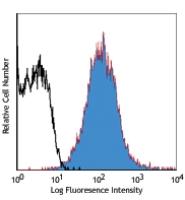-
Sign In
-

-
 Sony Biotechnology
Sony Biotechnology
-

-
 Sony Biotechnology
Sony Biotechnology
Alexa Fluor® 647 anti-Phosphotyrosine
Antibodies Single
Sony
PY20
Immunofluorescence
Mouse IgG2b, κ
Human,Mouse,Non-human primate,Other,Rat
KLH-conjugated phosphotyrosine
100 µg
2146540
$260.00
Description
Phosphorylation is a common modification of proteins that can result in alterations in protein function, protein-protein association, cellular localization, and protein-half life. Phosphorylation can occur on threonine, serine, and tyrosine residues. The PY20 monoclonal antibody recognizes phosphorylated tyrosine residues in all species tested (human, mouse, rat, dog, chicken, and frog). The PY20 antibody has been shown to be useful for flow cytometry, immunoprecipitation, Western blotting, and immunofluorescence staining.
Formulation
Phosphate-buffered solution, pH 7.2, containing 0.09% sodium azide.Recommended Usage
Each lot of this antibody is quality control tested by intracellular immunofluorescent staining with flow cytometric analysis. For flow cytometric staining, the suggested use of this reagent is ≤0.125 microg per 106 cells in 100 microL volume. It is recommended that the reagent be titrated for optimal performance for each application. NOTE: Do not use dilution buffer containing milk as they may interfere with antibody binding to proteins of interest. Dilution and blocking buffers containing 4% bovine serum albumin are recommended for use with this antibody.
* Alexa Fluor® 647 has a maximum emission of 668 nm when it is excited at 633nm / 635nm.
References
1. Vuori K, et al. 1995. J. Biol. Chem. 270:22259. (IP, WB)
2. Glenney J, et al. 1988. J. Immunol. Meth. 109:277. (IP, WB)
3. Prahalad P, et al. 2004. Am J Physiol Cell Physiol 286:C693. (IF)
4. Zentillin L, et al. 2009. FASEB J. 24:1467. PubMed
5. Philipsen L, et al. 2013. Mol Cell Proteomics. 12:2551. PubMed
6. Ramello MC, et al. 2014. Cell Death Dis. 6:5107. PubMed


